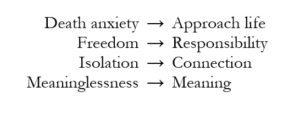
C.L.E.A.R. Thinking
Oh dear. If you know me, you know one of my pet peeves is “made to fit” acronyms. Ugh. I am familiar with the research about how that makes things easier to remember, yes. And I’m the first one to criticize, let’s say, Yalom for making the (would-be) “acronym” for the curative factors of group therapy AIIIIUECCCS. Not helpful. But, maybe it was just too many years of church sermons forced onto artificial acronym scaffolds that gave me a bad taste about it. I especially don’t like when the concept has to be twisted or something has to be grafted on to make the acronym work.
That being said, this one sort of made itself in a therapy session one day, so I’ll share it. Blerg.
CALM – brains that are all geared up don’t think very clearly. Or rather, they might think clearly, but they think in very limited ways – limited to RUN, FIGHT, APPEASE, etc. Useful for predators, not so much for the rest of life. This goes along with other bodily things that can get in the way of clear thinking, like hunger, exhaustion, and pain.
LOOSE – really good thinking is flexible. It’s structured enough that it’s coherent, but it’s not so structured that it loses its openness. Like any high-functioning system, clear thinking is semi-permeable.
EFFECTIVE – clear thinking prioritizes effectiveness. That means both recognizing potentially multiple goals and prioritizing them. Effectiveness over winning, unless winning is the only goal. Effectiveness over comfort, unless present comfort is the only goal. Etc.
ACCURATE – it’s got to happen in a reality-based way. Distortion is unavoidable, but the more we can be aware of our biases, the typical tricks of cognitive distortions, our own fantasies, etc., the clearer our thinking will be.
RELATIONAL – there’s no escaping that we exist in relationships, all the time, even when we’re alone. Keeping thinking relational means we’re better at taking others’ perspectives, more likely to consider real systems that are at play, and keeps our feet out of our mouths (pretty often).
Comment below: Ok, lay it on me. Should I give up the acronym? Is it forced? Could it be useful? Can you improve on it?!
Blocks provide you with everything you need to build a larger page. They contain a variety of content elements, such as images, buttons, headings, and more. These elements are arranged in rows and columns, which provide a useful structure, as well as a sense of balance within the overall composition. You can modify this structure using our intuitive drag and drop interface, which allows you to rearrange content to your heart’s content.



